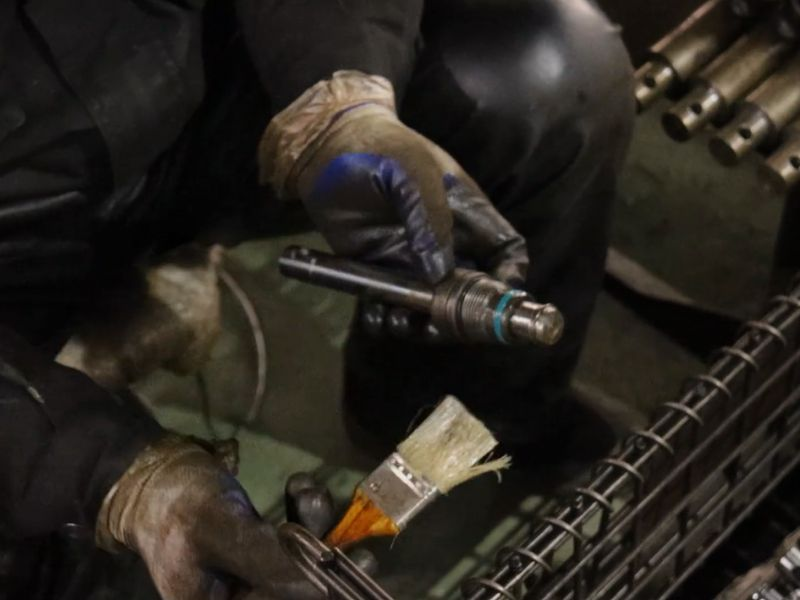1.Force Requirement: Determine the force needed, which is influenced by the load and the hydraulic system's pressure.
2.Stroke Length: Consider the stroke length required for the specific task.
3.Speed of Operation: Evaluate the speed of operation and adjust the cylinder size and system flow rate accordingly.
1.Environmental Conditions: Assess conditions such as temperature, potential contaminants, or exposure to corrosive substances.
2.Material and Seal Selection: Choose materials and seals that can withstand these environmental conditions.
Compatibility: Ensure the cylinder’s mounting style is compatible with the machinery and allows for proper alignment and operation.
Space Availability: Consider the space available for the cylinder. Compact or telescopic cylinders may be necessary in limited spaces.
System Compatibility: Match the cylinder’s pressure rating with the hydraulic system’s capabilities to ensure safe and efficient operation.
Consider the expected lifespan and ease of maintenance. A cylinder that is easier to service may reduce long-term costs.
1.Special Requirements: Sometimes, standard cylinders do not meet the specific requirements of an application. Customization is necessary in these cases.
2.Case Study: A bespoke solution was provided for an underwater application, requiring a cylinder with special coatings and seals to withstand high pressure and corrosive saltwater.
3.Benefits: Customized solutions ensure optimal performance, longevity, and safety in specialized applications.
1.Comparison Tools: Utilize tools or calculators provided by manufacturers to compare different models and configurations.
2.Total Cost of Ownership: Consider not just the initial purchase price but also the long-term costs associated with maintenance, repairs, and operational efficiency.
3.Performance Metrics: Evaluate performance metrics such as efficiency, response time, and load capacity to ensure the cylinder meets the operational demands.

1.Pre-Installation Check:
• Inspect for Damage: Examine the cylinder for any shipping damage and ensure all components are present.
• Verify Specifications: Confirm that the specifications match the application requirements.
2.Prepare the Work Area:
• Clean and Well-Lit: Ensure the area is clean, well-lit, and spacious enough for safe installation.
• Tools and Equipment: Have all necessary tools and equipment readily available.
3.Installation Process:
• Follow Instructions: Adhere to the manufacturer-provided instructions or guidelines.
• Mounting: Securely mount the cylinder, ensuring correct alignment to prevent undue stress or wear.
• Hydraulic Connections: Carefully connect the hydraulic lines, ensuring tight and leak-free connections.
• Bleed Air: Bleed air from the system to prevent erratic cylinder operation.
4.Post-Installation Check:
• Testing: Test the cylinder under controlled conditions to ensure proper functioning.
• Check for Issues: Inspect for leaks, unusual noises, or erratic movements.
1.Personal Protective Equipment (PPE):
• Always wear the correct PPE, including gloves, eye protection, and steel-toed boots.
Lifting and Handling:
• Lifting Equipment: Use appropriate lifting equipment to handle heavy cylinders.
• Ergonomic Practices: Follow ergonomic principles to prevent injuries during manual handling.
2.Avoiding High-Pressure Hazards:
• Awareness of Hazards: Be aware of the hazards associated with high-pressure hydraulic systems.
• Safe Inspection: Never inspect for leaks with your hands; use a piece of cardboard or a mirror instead.
3.Legal and Regulatory Considerations:
• Compliance with Standards: Ensure that the installation complies with relevant industry standards, such as ISO 6020 for general-purpose cylinders.
• Regional Regulations: Adhere to regional safety regulations, such as OSHA in the United States and CE marking in Europe.
4.Documentation and Record Keeping:
• Installation Records: Maintain records of the installation, including any modifications or customizations.
• Maintenance Logs: Keep a log of maintenance and inspections for legal compliance and in case of audits.
Proper maintenance is essential for ensuring the longevity and optimal performance of welded hydraulic cylinders. A well-maintained cylinder not only functions better but also reduces safety risks. Here’s a guideline, along with common issues and their solutions.
1.Regular Inspection: Check for signs of wear, leaks, or damage to the cylinder, seals, and piston rod.
2.Cleanliness: Keep the cylinder and surrounding area clean to prevent contamination of the hydraulic system.
3.Fluid Check: Regularly check hydraulic fluid levels and quality. Change or filter the fluid as recommended by the manufacturer.
4.Seal Inspection: Inspect seals for signs of wear or leakage and replace them as necessary.
5.Rod Inspection: Check for scratches or dents on the piston rod, as these can damage seals and lead to leaks.
6.Alignment Check: Ensure the cylinder is correctly aligned to prevent uneven wear and stress.
7.Lubrication: Ensure proper lubrication of moving parts according to the manufacturer’s guidelines.
1.Leakage:
Cause: Worn seals or damaged barrel.
Solution: Replace the seals or repair the barrel damage. Ensure proper installation to avoid future leaks.
2.Rod Wear or Damage:
Cause: Misalignment, external damage, or abrasive particles.
Solution: Repair or replace the rod, ensure proper alignment, and maintain a clean operating environment.
3.Erratic Movement:
Cause: Air in the system, contaminated fluid, or worn components.
Solution: Bleed air from the system, replace or filter the hydraulic fluid, and replace any worn parts.
1.Repair:
Consider if the issue is minor: Such as seal replacement or rod repair.
Weigh the cost of repairs: Against the cylinder’s remaining lifespan.
Consider downtime and availability: Of replacement parts.
2.Replace:
Advised if the cylinder has significant damage: Or if it is at the end of its service life.
Consider if newer models offer better efficiency or features.
Assess the long-term cost savings and reliability: Of a new cylinder.
3.Safety Considerations:
Always follow manufacturer guidelines: For maintenance and repairs.
Consider the potential safety risks: Of a malfunctioning cylinder in your decision-making process.
Regularly train staff: On proper maintenance procedures and safety practices.
In this comprehensive guide, we explore the complex world of welded hydraulic cylinders, uncovering their definitions, mechanisms, and types. From understanding the basic components and operations of these robust devices to delving into the specifics of maintenance, troubleshooting, and safe installation practices.